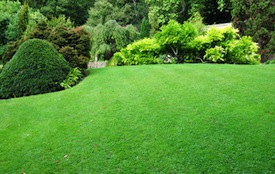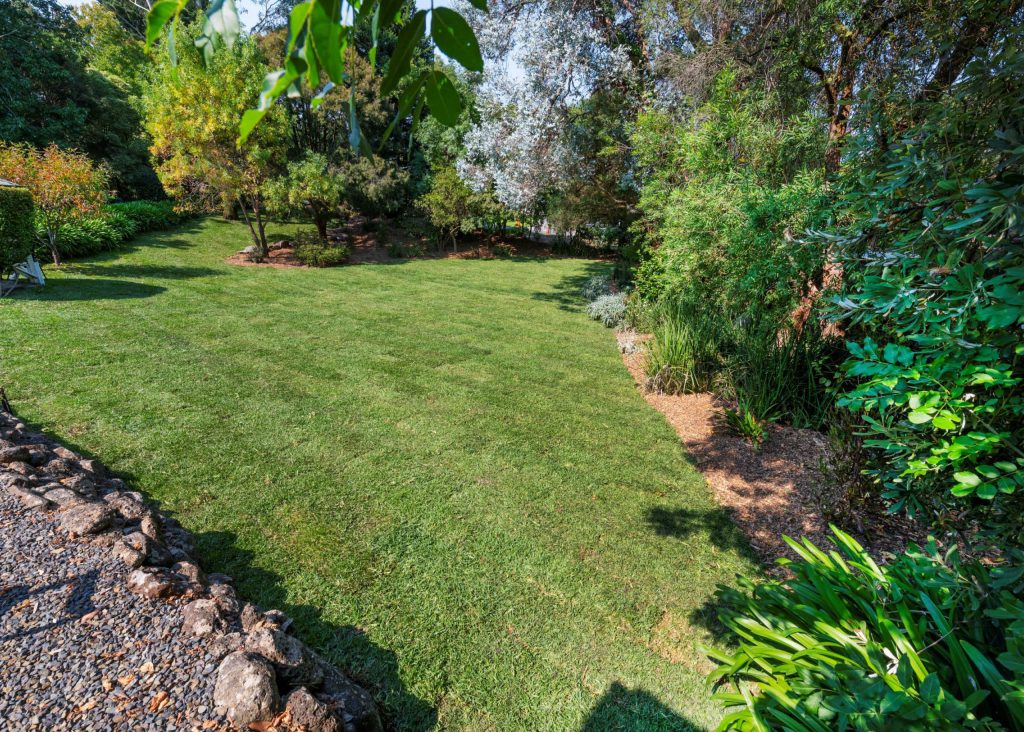Broadleaf Carpetgrass – Is It the Right Grass for You?
This perennial warm-season grass is an appealing choice for homeowners in tropical parts of Australia – especially northern Queensland. With excellent shade but poor drought ...

 St Augustine’s Grass is commonly known as Buffalo grass in Australia. It is a warm-season turf known for its luxurious feel, ability to maintain winter colour in temperate climates, and can withstand a range of environmental extremes, including drought, shade and high traffic.
St Augustine’s Grass is commonly known as Buffalo grass in Australia. It is a warm-season turf known for its luxurious feel, ability to maintain winter colour in temperate climates, and can withstand a range of environmental extremes, including drought, shade and high traffic.
 St Augustine Grass, also known as Buffalo Grass in Australia, is a low-maintenance grass featuring broad, coarse-textured grass blades and deep green colour.
St Augustine Grass, also known as Buffalo Grass in Australia, is a low-maintenance grass featuring broad, coarse-textured grass blades and deep green colour.
Despite being warm-season grass, St Augustine Grass is known for its ability to maintain its winter colour, even in the cooler regions of sub-tropical and temperate Australia. Newer varieties of this grass, such as Prestige Buffalo, Palmetto Buffalo and Sapphire Buffalo, have been bred for their softer leaves and low thatch, which make it pleasant to walk on, and its low-maintenance, easy-care characteristics make it a popular choice for lawns.
In cold to frost-prone regions, St Augustine Grass does have winter dormancy but returns to life once the soil begins to warm up.
 One of the main reasons for St Augustine’s popularity is its shade tolerance. St Augustine grass can tolerate up to 70% shade, making it a good option for areas that receive partial sun throughout the day.
One of the main reasons for St Augustine’s popularity is its shade tolerance. St Augustine grass can tolerate up to 70% shade, making it a good option for areas that receive partial sun throughout the day.
However, it is important to note that St Augustine, like most grasses, does need some direct sunlight each day in order to stay healthy. If you are looking for grass that can thrive in full shade, you may want to consider a different variety.
St Augustine Grass has excellent drought tolerance, making it a great choice for Australia’s warmer regions. It is efficient in its water usage, which means it can stay greener for longer during dry conditions.
If it does brown off in extremely dry seasons, St Augustine Grass has a full and fast recovery rate, making it an excellent choice for those looking to maintain a green lawn during periods of drought.
In a long drought, it will need some water to survive, if it dies off completely the grass will struggle to recover due to the lack of rhizomes (the underground stems).
 St Augustine Grass is able to withstand heavy foot traffic and recovers quickly from damage. This makes it ideal for families with young children who are constantly running and playing on the lawn. In addition, St Augustine Grass is also resistant to disease and pests, making it a low-maintenance option for busy homeowners.
St Augustine Grass is able to withstand heavy foot traffic and recovers quickly from damage. This makes it ideal for families with young children who are constantly running and playing on the lawn. In addition, St Augustine Grass is also resistant to disease and pests, making it a low-maintenance option for busy homeowners.
Like most lawns, St Augustine grass needs regular care and maintenance to stay healthy and thrive.
The good news is that it is relatively easy to care for, and a little effort can go a long way. In addition to regular watering and mowing, an important part of maintaining St. Augustine Grass is to follow a yearly maintenance calendar, including regular aeration, fertilising, and control of weeds, pests and disease.
 Optimally, St Augustine Grass should be mowed at a height of between 25mm and 50mm.
Optimally, St Augustine Grass should be mowed at a height of between 25mm and 50mm.
Mowing too short can stress the lawn and make it more susceptible to disease. It can also lead to increased water evaporation, which means you’ll have to water it more often. On the other hand, if you mow too high, the grass will tend to grow more quickly, and thatch – the accumulation of dead grass matter – will develop more quickly.
You may need to adjust your mowing schedule to suit the seasons – in winter, you should mow every 3 to 6 weeks, while in summer, mowing should occur every 7 to 10 days.
 Newly laid St Augustine Grass should be watered immediately after installation, and then multiple times per day to keep the plants supplied with water while they establish a new root system (approximately 10-20 days or until you can no longer lift the slab of turf from the ground).
Newly laid St Augustine Grass should be watered immediately after installation, and then multiple times per day to keep the plants supplied with water while they establish a new root system (approximately 10-20 days or until you can no longer lift the slab of turf from the ground).
Initially apply 20mm to 30mm of water, enough to saturate the root zone without causing runoff, and then lightly water multiple times per day to prevent the soil or plants from drying out.
Once the grass is established, you should aim for more frequent, shallow watering to encourage root growth. In temperature climates and with proper watering, St Augustine Grass will remain green and healthy throughout the year.
It is important to fertilise your St Augustine lawn on a regular basis.
Slow-release fertilisers are a good option, as they provide a steady supply of nutrients over a long period of time. The best time to apply fertiliser is during April and early September. Avoid applying fertiliser during the heat of summer, as this can damage the grass.
 Two of the most common pests of St Augustine’s Grass are Lawn Grubs and African Black Beetles.
Two of the most common pests of St Augustine’s Grass are Lawn Grubs and African Black Beetles.
Lawn Grubs can damage the roots of your grass, causing it to turn brown and die.
African Black Beetles can also cause extensive damage, particularly to young plants.
Both pests are difficult to control once they become established, so it’s important to take preventive measures. Inspect your lawn regularly for signs of infestation and take quick action to eradicate them before they cause serious damage.
Keeping your lawn weed-free will help maintain its health and vigour.
Hand removal of weeds as they appear is the best method for removing small numbers of weeds. However, if the weed problem is more widespread, then you will need to use selective herbicide containing the active ingredients bromoxyl or MCPA, which are safe to use on St Augustine Grass.
It is essential that you thoroughly read the label and all instructions before application and ensure that the selective herbicide you are using is safe for St Augustine’s/Buffalo Grass.
St Augustine’s/Buffalo Grass is highly susceptible to damage from some herbicides which are safe to use on other common lawn grasses, so make sure you are using the correct one.
 Brown Patch is a fungal disease that can affect your St Augustine’s Grass under warm, humid conditions. It can be characterised by circular brown patches of lawn that progressively get larger as the disease spreads.
Brown Patch is a fungal disease that can affect your St Augustine’s Grass under warm, humid conditions. It can be characterised by circular brown patches of lawn that progressively get larger as the disease spreads.
Brown Patch commonly occurs when excess water is allowed to pool on the lawn in humid weather. To prevent Brown Patch, you should avoid watering at night, and aerate and dethatch your lawn regularly to allow air and water to circulate freely.
If necessary, use a fungicide to treat the problem.
myhomeTURF has three Buffalo Turf varieties suitable for homeowners.
 This new generation Soft Leaf Buffalo is one of the best and newest Buffalo Grasses on the market. It is known for its consistent deep green colour, hard wearing, good recovery and drought tolerance. It also has up to 70% shade tolerance with low wear and up to 50% shade tolerance with moderate to high wear.
This new generation Soft Leaf Buffalo is one of the best and newest Buffalo Grasses on the market. It is known for its consistent deep green colour, hard wearing, good recovery and drought tolerance. It also has up to 70% shade tolerance with low wear and up to 50% shade tolerance with moderate to high wear.
Where it grows: Prestige Soft Leaf Buffalo is well-suited for most parts of Australia including much of Queensland, New South Wales, ACT, Victoria, South Australia and Western Australia.
Expect to pay: Between $13 and $20 per square metre.
 This Soft Leaf Buffalo was rated as number one Buffalo for shade tolerance in independent Horticulture Innovation and Department of Primary Industry trials. Sapphire Buffalo also recovers well from wear, is a low thatch type and has good winter colour. The folding of its leaf creates extra softness and aids to protect it from cold and frosty conditions.
This Soft Leaf Buffalo was rated as number one Buffalo for shade tolerance in independent Horticulture Innovation and Department of Primary Industry trials. Sapphire Buffalo also recovers well from wear, is a low thatch type and has good winter colour. The folding of its leaf creates extra softness and aids to protect it from cold and frosty conditions.
Where it grows: Sapphire Soft Leaf Buffalo is well-suited for most parts of Australia including much of Queensland, New South Wales, ACT, Victoria, South Australia and Western Australia.
Expect to pay: Between $12 and $20 per square metre.
 Palmetto is the biggest selling Buffalo in the World. It offers low maintenance, less watering and is a great hard-wearing option for families with kids and pets. Palmetto’s dense growth means it is harder for weeds to invade the lawn.
Palmetto is the biggest selling Buffalo in the World. It offers low maintenance, less watering and is a great hard-wearing option for families with kids and pets. Palmetto’s dense growth means it is harder for weeds to invade the lawn.
Where it grows: Palmetto Soft Leaf Buffalo is well-suited for most parts of Australia including much of Queensland, New South Wales, ACT, Victoria, South Australia and Western Australia.
Expect to pay: Between $12 and $20 per square metre.
St Augustine’s Grass, also known as Buffalo Grass, is a versatile, easy-care turf variety that is ideal for family homes. Drought resistant, shade tolerant and featuring a stunning deep green colour, it performs well in most Australian climates, provided you apply a regular schedule of maintenance, including regular mowing, watering, fertiliser to keep it in top condition.
Find a local supplier of Buffalo Turf using myhomeTURF’s online supplier locator tool.